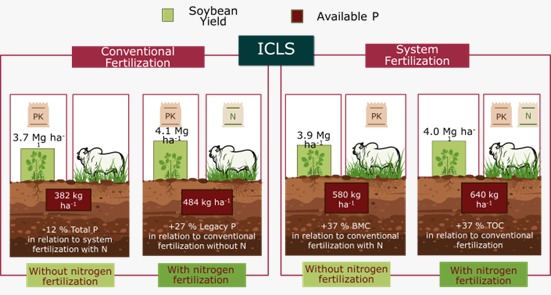Early termination of Sudan grass (Sorghum sudanense) used as soil cover in a soybean cropping system in the Brazilian Cerrado
06/Nov/2025
ABSTRACT Sudan grass (Sorghum sudanense (Piper) Stapf.) shows potential as a cover crop under the no-tillage system in soybean growing under the conditions of the Brazilian Cerrado region, due to high biomass production under water deficit. The large amount of biomass produced can improve soil microbiological activity, but may also negatively affect subsequent soybean yield due to nutrient competition, particularly if termination of the cover crop is delayed. To improves the use of Sudan grass as a cover crop, this […]
Fertilization strategies to improve phosphorus availability and soil quality in integrated crop-livestock system in tropical soils
13/Oct/2025
ABSTRACT Exploring different fertilization strategies in an integrated crop-livestock system (ICLS) can enhance soil phosphorus (P) availability and improve soil quality, ultimately leading to higher yield. This study aimed to evaluate different fertilization strategies in ICLS and their effects on soil P fractions, soil quality and soybean grain yield in a tropical soil. Initiated in 2019, the experiment tested four fertilization strategies: 1) Conventional fertilization with P and K applied at soybean sowing (CF); 2) CF + N fertilization in […]
Soil Organic Matter Quality in Jatropha spp. Plantations in Different Edaphoclimatic Conditions
09/Mar/2017
ABSTRACT The substitution of native vegetation by agricultural ecosystems can change the quantity and quality of soil organic matter (SOM), and the intensity of these changes depends on the soil type, climate, and land use. The objective of this study was to evaluate the quality of organic matter in chronosequences of Jatropha cultivation in contrasting soil and climatic conditions. Soil samples were evaluated at depths of 0.00-0.10, 0.20-0.30, and 0.80-1.00 m in chronosequences located in Planaltina, Distrito Federal (Cerrado-Pasture-Jatropha), Dourados, […]
Biological Properties and Organic Matter Dynamics of Soil in Pasture and Natural Regeneration Areas in the Atlantic Forest Biome
05/Oct/2016
ABSTRACT The removal of original vegetation for crops and pasture production and then followed by natural regeneration is a standard practice in the Atlantic Forest, which has produced patches with different degrees of degradation and regeneration across the landscape. The aim of this study was to evaluate the effects of replacement of native forest by pasture and natural regeneration of vegetation on soil and on soil organic matter (SOM) dynamics in the dry and rainy season in an Atlantic Forest […]
Carbon Stocks in Compartments of Soil Organic Matter 31 Years after Substitution of Native Cerrado Vegetation by Agroecosystems
13/Apr/2016
ABSTRACT Changes in carbon stocks in different compartments of soil organic matter of a clayey Latossolo Vermelho Distrófico (Typic Haplustox), caused by the substitution of native savanna vegetation (cerrado sensu stricto) by agroecosystems, were assessed after 31 years of cultivation. Under native vegetation, a stock of 164.5 Mg ha-1 C was estimated in the 0.00-1.00 m layer. After 31 years of cultivation, these changes in soil C stocks were detected to a depth of 0.60 m. In the case of […]
Chemical and Biochemical Properties of Oxisols after Sewage Sludge Application for 16 Years
01/Sep/2015
ABSTRACT The large production of sewage sludge (SS), especially in large urban centers, has led to the suggestion of using this waste as fertilizer in agriculture. The economic viability of this action is great and contributes to improve the environment by cycling the nutrients present in this waste, including high contents of organic matter and plant nutrients. This study evaluated the chemical and biochemical properties of Dystrophic and Eutroferric Latossolos Vermelhos (Oxisols) under corn and after SS application at different […]
Biological indicators of two soils with incorporation of a byproduct from the coffee agroindustry
01/Oct/2014
The addition of organic residue byproducts in the soil may lead to changes in the dynamics of soil organic matter, influencing the activity and the use of C by microorganisms in the soil. The aim of this study was to evaluate the influence of the application of increasing rates of a byproduct from a coffee agroindustry on the biological properties of two soils with different clay contents as a function of incubation time. A randomized block experimental design was used […]
Effect of management systems and cover crops on organic matter dynamics of soil under vegetables
01/Jun/2014
Vegetable production in conservation tillage has increased in Brazil, with positive effects on the soil quality. Since management systems alter the quantity and quality of organic matter, this study evaluated the influence of different management systems and cover crops on the organic matter dynamics of a dystrophic Red Latosol under vegetables. The treatments consisted of the combination of three soil tillage systems: no-tillage (NT), reduced tillage (RT) and conventional tillage (CT) and of two cover crops: maize monoculture and maize-mucuna […]
Soil quality indicators in a rhodic kandiudult under different uses in northern Parana, Brazil
01/Feb/2014
Sustainable use of soil, maintaining or improving its quality, is one of the goals of diversification in farmlands. From this point of view, bioindicators associated with C, N and P cycling can be used in assessments of land-use effects on soil quality. The aim of this study was to investigate chemical, microbiological and biochemical properties of soil associated with C, N and P under different land uses in a farm property with diversified activity in northern Parana, Brazil. Seven areas […]
Soil nitrogen, carbon and compaction as limiting factors for the recovery of degraded riparian forests
01/Oct/2013
Forest recovery, especially of riparian forests, has become a key factor in the environmental planning of agriculture, to protect water resources and the biota. However, traditional agricultural crops have not only affected nutrient cycling by the loss of organic matter and of microbial biomass and activity, but also increased soil compaction, which can later affect reforestation. The aim of this study was to identify the soil (physical, chemical and microbiological) properties that most influence the litter moisture contents of C, […]

